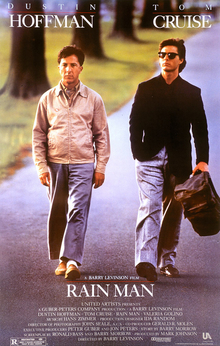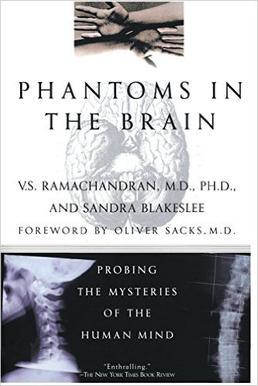
Rain Man is a 1988 American road comedy-drama film directed by Barry Levinson and written by Barry Morrow and Ronald Bass. It tells the story of abrasive, selfish, young wheeler-dealer Charlie Babbitt, who discovers that his estranged father has died and bequeathed virtually all of his multimillion-dollar estate to his other son, Raymond, an autistic savant of whose existence Charlie was unaware. Charlie is left with only his father's beloved vintage car and rosebushes. Valeria Golino also stars as Charlie's girlfriend, Susanna. Morrow created the character of Raymond after meeting Kim Peek, a real-life savant; his characterization was based on both Peek and Bill Sackter, a good friend of Morrow who was the subject of Bill, an earlier film that Morrow wrote.

Oliver Wolf Sacks was a British neurologist, naturalist, historian of science, and writer. Born in London, Sacks received his medical degree in 1958 from The Queen's College, Oxford, before moving to the United States, where he spent most of his career. He interned at Mount Zion Hospital in San Francisco and completed his residency in neurology and neuropathology at the University of California, Los Angeles (UCLA). Later, he served as neurologist at Beth Abraham Hospital's chronic-care facility in the Bronx, where he worked with a group of survivors of the 1920s sleeping sickness encephalitis lethargica, who had been unable to move on their own for decades. His treatment of those patients became the basis of his 1973 book Awakenings, which was adapted into an Academy Award-nominated feature film in 1990, starring Robin Williams and Robert De Niro.

Agnosia is a neurological disorder characterized by an inability to process sensory information. Often there is a loss of ability to recognize objects, persons, sounds, shapes, or smells while the specific sense is not defective nor is there any significant memory loss. It is usually associated with brain injury or neurological illness, particularly after damage to the occipitotemporal border, which is part of the ventral stream. Agnosia only affects a single modality, such as vision or hearing. More recently, a top-down interruption is considered to cause the disturbance of handling perceptual information.

Derek Paravicini is an English autistic savant known as a musical prodigy. He resides in London.

Hemispatial neglect is a neuropsychological condition in which, after damage to one hemisphere of the brain, a deficit in attention and awareness towards the side of space opposite brain damage is observed. It is defined by the inability of a person to process and perceive stimuli towards the contralesional side of the body or environment. Hemispatial neglect is very commonly contralateral to the damaged hemisphere, but instances of ipsilesional neglect have been reported.
"Funes the Memorious" is a fantasy short story by Argentine writer Jorge Luis Borges (1899–1986). First published in La Nación of June 1942, it appeared in the 1944 anthology Ficciones, part two (Artifices). The first English translation appeared in 1954 in Avon Modern Writing No. 2.
Visual agnosia is an impairment in recognition of visually presented objects. It is not due to a deficit in vision, language, memory, or intellect. While cortical blindness results from lesions to primary visual cortex, visual agnosia is often due to damage to more anterior cortex such as the posterior occipital and/or temporal lobe(s) in the brain.[2] There are two types of visual agnosia: apperceptive agnosia and associative agnosia.
Clive Wearing is a British former musicologist, conductor, tenor and pianist who developed chronic anterograde and retrograde amnesia in 1985. Since then, he has lacked the ability to form new memories and cannot recall aspects of his memories, frequently believing that he has only recently awoken from a comatose state.
Auditory verbal agnosia (AVA), also known as pure word deafness, is the inability to comprehend speech. Individuals with this disorder lose the ability to understand language, repeat words, and write from dictation. Some patients with AVA describe hearing spoken language as meaningless noise, often as though the person speaking was doing so in a foreign language. However, spontaneous speaking, reading, and writing are preserved. The maintenance of the ability to process non-speech auditory information, including music, also remains relatively more intact than spoken language comprehension. Individuals who exhibit pure word deafness are also still able to recognize non-verbal sounds. The ability to interpret language via lip reading, hand gestures, and context clues is preserved as well. Sometimes, this agnosia is preceded by cortical deafness; however, this is not always the case. Researchers have documented that in most patients exhibiting auditory verbal agnosia, the discrimination of consonants is more difficult than that of vowels, but as with most neurological disorders, there is variation among patients.

An Anthropologist on Mars: Seven Paradoxical Tales is a 1995 book by neurologist Oliver Sacks consisting of seven medical case histories of individuals with neurological conditions such as autism and Tourette syndrome. An Anthropologist on Mars follows up on many of the themes Sacks explored in his 1985 book, The Man Who Mistook His Wife for a Hat, but here the essays are significantly longer and Sacks has more of an opportunity to discuss each subject with more depth and to explore historical case studies of patients with similar symptoms. In addition, Sacks studies his patients outside the hospital, often traveling considerable distances to interact with his subjects in their own environments. Sacks concludes that "defects, disorders, [and] diseases... can play a paradoxical role, by bringing out latent powers, developments, evolutions, forms of life that might never be seen, or even be imaginable, in their absence".
The Man Who Mistook His Wife for a Hat is a one-act chamber opera by Michael Nyman to an English-language libretto by Christopher Rawlence, adapted from the case study of the same name by Oliver Sacks by Nyman, Rawlence, and Michael Morris. It was first performed at the Institute of Contemporary Arts, London, on 27 October 1986.

The Echo Maker is a 2006 novel by American writer Richard Powers. It won the National Book Award for Fiction and was a Pulitzer Prize for Fiction finalist.

Hemianopsia, or hemianopia, is a visual field loss on the left or right side of the vertical midline. It can affect one eye but usually affects both eyes.
Hyperosmia is an increased olfactory acuity, usually caused by a lower threshold for odor. This perceptual disorder arises when there is an abnormally increased signal at any point between the olfactory receptors and the olfactory cortex. The causes of hyperosmia may be genetic, hormonal, environmental or the result of benzodiazepine withdrawal syndrome.

Thorns is a science fiction novel by American author Robert Silverberg, published as a paperback original in 1967, and a Nebula and Hugo Awards nominee.
Auditory agnosia is a form of agnosia that manifests itself primarily in the inability to recognize or differentiate between sounds. It is not a defect of the ear or "hearing", but rather a neurological inability of the brain to process sound meaning. While auditory agnosia impairs the understanding of sounds, other abilities such as reading, writing, and speaking are not hindered. It is caused by bilateral damage to the anterior superior temporal gyrus, which is part of the auditory pathway responsible for sound recognition, the auditory "what" pathway.

Proprioception is the sense of self-movement, force, and body position.
Exceptional memory is the ability to have accurate and detailed recall in a variety of ways, including hyperthymesia, eidetic memory, synesthesia, and emotional memory. Exceptional memory is also prevalent in those with savant syndrome and mnemonists.

Phantoms in the Brain: Probing the Mysteries of the Human Mind is a 1998 popular science book by neuroscientist V.S. Ramachandran and New York Times science writer Sandra Blakeslee, discussing neurophysiology and neuropsychology as revealed by case studies of neurological disorders.

A Leg to Stand On is a 1984 autobiographical account by neurologist Oliver Sacks describing his recovery from psychogenic leg paralysis following a mountaineering accident. The book has been described as a skillful description of the depersonalization of functional neurological symptoms. Neuropsychiatric specialists who have recommended reading the book to their patients have found it can help them cope with their depersonalization symptoms.












